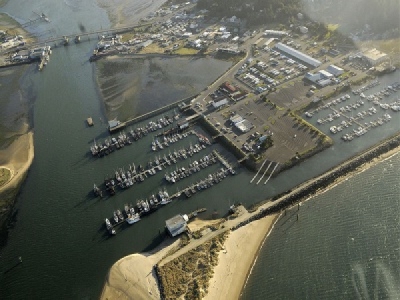
Posted on July 25, 2017
By Spencer Cole, The World
The Port of Coos Bay has the task of maintaining the largest deep water channel between San Francisco and Seattle and all the additional transportation infrastructure that goes along with it.
In the coming years, the Port will focus its efforts on rehabilitatiing the Coos Bay rail line tunnel, replacing the Vaughn Viaduct Bridge and installing a stormwater system at the Charleston shipyard.
Earlier this spring, the Port announced plans for a $400 million channel modification project.
Dredging the channel
The project would involve dredging the current channel and deepening it 8 feet along more than 8 miles of river, beginning near Roseburg Forest Products. The same stretch west of the McCullough Bridge would likewise be widened 150 feet.
A 1,400-feet-long by 1,100-feet-wide “vessel-turning basin” would also be created at the upper end of the proposed modification.
Currently, the channel sits at a depth of 37 feet with a width of 300 feet.
Those numbers would change to 45-feet deep by 450-feet wide at the project’s conclusion.
If completed, the work would be the largest and deepest dredging project in Coos Bay’s history.
According to Director of Maritime Operations Mike Dunning, the Port is working collaboratively with the state and “various private partners” to fund the project.
External Affairs Manager Margaret Barber said part of the funding came from a $60 million state grant that the Port is set to receive in three installments.
She said the Port was also putting up money along with Jordan Cove LNG but declined to specify amounts.
The remaining funding is still being determined, according to Port officials.
Rail Line tunnel rehabilitation project
The Port is also in the early phases of a $19.5 million project to improve all nine tunnels along the Coos Bay Rail Line, according to Barber.
The longest tunnel on the line spans 4,200 feet.
The repairs are long overdue — all of the tunnels are aged 100 years or older — and some of the tunnels still have the original timber tunnel support structures.
The project will not only include structural repairs, it will also address some significant drainage issues, Barber said.
“This project is an essential step in preserving and maintaining the line, which ensures that the Coos Bay Rail Link can continue to operate safely and efficiently,” she added.
The companies that utilize rail shipping in the South Coast employ over 750 people and move more than $275 million in products annually, according to Port officials.
“Rail service is an essential component of our intermodal transportation network in Southwest Oregon,” said Fred Jacquot, Port development director. “The Tunnel Rehabilitation Project will help to ensure that we can keep freight moving in and out of the region for years to come.”
Charleston Shipyard stormwater project
Meanwhile, the Charleston Shipyard will soon welcome a state-of-the-art stormwater treatment system.
The Port will be investing between $650,000-$750,000 in the new system, which will be one of the first systems of its kind to be implemented on the Oregon Coast, Barber said.
The technology that the new system utilizes is called Chitosan Enhanced Sand Filtration, which filters stormwater runoff before it enters either the South or Joe Ney sloughs.
The system will move the filtration process from a passive system, to an active system, improving the quality of the runoff by more than ten times, Port officials say.
The system is designed to target zinc and copper, two elements commonly found in marine paint: zinc is used in paint to reduce corrosion, while copper is used to reduce the amount of barnacles that affix to the underside of vessels.
Barber said the new system will minimize the presence of those elements in stormwater runoff.
Project Manager Joe Caruso said “the new stormwater system will enhance water quality in the vicinity of our shipyard in Charleston and continue the Port’s goal of being responsible environmental stewards.”
Vaughn Viaduct bridge replacement
The Vaughn Viaduct Bridge project will replace the existing 100-year-old structure with a newly constructed bridge which will be classified for speeds of up to 40 miles per hour, according to Barber. She said the new bridge will be a five-span precast concrete girder structure.
The existing bridge will be utilized for rail traffic on the existing tracks while the new bridge is constructed alongside.
Once construction is complete, the rail line will be connected to the new bridge over the course of one weekend, and disassembly of the old Vaughn Viaduct Bridge will then commence.
Port officials say the bridge will be seismically retrofitted.
All of the traffic on the line either travels over or switches across the Vaughn Viaduct — without the Vaughn Viaduct, rail traffic and the goods it transports are unable to flow into or out of the South Coast. Additionally, the new bridge is designed to accommodate unit train traffic, which is essential for the future growth, development, and long term viability of the line.
Source: The World





